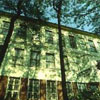Istanbul Hagia Sophia Museum Mahmut I Library

It is located between two wall supports at the southern part of Ayasophia. It is an interesting product of Turkish construction and decorative arts. It was built by Sultan Mahmud I in 1739. The library consists of a reading room, the room where the books were kept under protection (hazine-i kutub) and a corridor between these two sections. Reading room is separated from the main space of Ayasophia with a glass partition born by six colons with diamond shaped capitals and covered with a bronze mesh. The double doors of the entrance are also covered with a bronze mesh decorated with flowers and scrolling branches and has two handles engraved with "Ya Fettah". The walls of the reading room are decorated with tiles and calligraphic friezes. On the wall opposite to the door, there is the porphyry monogram of Sultan Mahmud I, bordered with green tiles.
The corridor joining the reading room and the book storage is decorated with tile panels with flower, rose, carnation, tulip and cypress motives. These panels are unique in terms of color and form.
The room of the books consists of two spaces separated by 4 columns and a platform. The first section is covered with a dome and the second with a vault. The dome rests on an octagonal ring. There is a wooden book cupboard at the center of this space. On the inside of the door which is the entrance to this section from the corridor there is the monogram of Sultan Mahmud I and a 15 disyichs poem about the construction ending with the date h. 1152. (1739).
Iznik, Kutahya and Tekfur palace tiles of 16 -17 -18th centuries were used in combination in the library. The 16th century Iznik tiles in the book room and the flowered spring branches composition on the tiles of the corridor which are from the same century, are among the best examples of the Turkish tile art.
 It is located between two wall supports at the southern part of Ayasophia. It is an interesting product of Turkish construction and decorative arts. It was built by Sultan Mahmud I in 1739. The library consists of a reading room, the room where the books were kept under protection (hazine-i kutub) and a corridor between these two sections. Reading room is separated from the main space of Ayasophia with a glass partition born by six colons with diamond shaped capitals and covered with a bronze mesh. The double doors of the entrance are also covered with a bronze mesh decorated with flowers and scrolling branches and has two handles engraved with "Ya Fettah". The walls of the reading room are decorated with tiles and calligraphic friezes. On the wall opposite to the door, there is the porphyry monogram of Sultan Mahmud I, bordered with green tiles.
It is located between two wall supports at the southern part of Ayasophia. It is an interesting product of Turkish construction and decorative arts. It was built by Sultan Mahmud I in 1739. The library consists of a reading room, the room where the books were kept under protection (hazine-i kutub) and a corridor between these two sections. Reading room is separated from the main space of Ayasophia with a glass partition born by six colons with diamond shaped capitals and covered with a bronze mesh. The double doors of the entrance are also covered with a bronze mesh decorated with flowers and scrolling branches and has two handles engraved with "Ya Fettah". The walls of the reading room are decorated with tiles and calligraphic friezes. On the wall opposite to the door, there is the porphyry monogram of Sultan Mahmud I, bordered with green tiles.